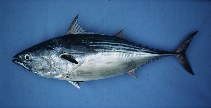Add your observation in Fish Watcher
| Native range | All suitable habitat | Point map | Year 2050 |

|
| This map was computer-generated and has not yet been reviewed. |
| Euthynnus lineatus AquaMaps Data sources: GBIF OBIS |
Upload your photos and videos
Pictures | Videos | Google imageEuthynnus lineatus
Picture by Béarez, P.
Pictures | Videos | Google imageEuthynnus lineatus
Picture by Béarez, P.
United States (contiguous states) country information
Common names:
Black skipjack
Occurrence: native
Salinity: marine
Abundance: | Ref:
Importance: | Ref:
Aquaculture: | Ref:
Regulations: | Ref:
Uses: no uses
Comments:
National Checklist:
Country Information: https://www.cia.gov/library/publications/resources/the-world-factbook/geos/us.html
National Fisheries Authority: http://www.nmfs.gov
Occurrences: Occurrences Point map
Main Ref: Collette, B.B. and C.E. Nauen, 1983
National Database:
Occurrence: native
Salinity: marine
Abundance: | Ref:
Importance: | Ref:
Aquaculture: | Ref:
Regulations: | Ref:
Uses: no uses
Comments:
National Checklist:
Country Information: https://www.cia.gov/library/publications/resources/the-world-factbook/geos/us.html
National Fisheries Authority: http://www.nmfs.gov
Occurrences: Occurrences Point map
Main Ref: Collette, B.B. and C.E. Nauen, 1983
National Database:
Common names from other countries
Classification / Names Populärnamn | synonymer | Catalog of Fishes(Släkte, Arter) | ITIS | CoL | WoRMS | Cloffa
> Scombriformes (Mackerels) > Scombridae (Mackerels, tunas, bonitos) > Scombrinae
Etymology: Euthynnus: Greek, eu = good + Greek, thynnos = tunna (Ref. 45335).
Etymology: Euthynnus: Greek, eu = good + Greek, thynnos = tunna (Ref. 45335).
Environment: milieu / climate zone / depth range / distribution range Ekologi
marina; havsvandrande (Ref. 51243); djupintervall 0 - 40 m (Ref. 5227). Tropical; 39°N - 16°S, 128°W - 77°W (Ref. 168)
Utbredning Länder | FAO områden | Ekosystem | Förekomster | Point map | Utplanteringar | Faunafri
Eastern Pacific: off San Simeon, California, USA southward to the Galapagos Islands and northern Peru. Two stray specimens collected in the Hawaiian Islands.
Size / Vikt / Age
Maturity: Lm ? range ? - ? cm
Max length : 84.0 cm FL hane/ej könsbestämd; (Ref. 168); common length : 60.0 cm FL hane/ej könsbestämd; (Ref. 9340); publicerad maxvikt: 9.1 kg (Ref. 168)
Max length : 84.0 cm FL hane/ej könsbestämd; (Ref. 168); common length : 60.0 cm FL hane/ej könsbestämd; (Ref. 9340); publicerad maxvikt: 9.1 kg (Ref. 168)
Short description Bestämningsnycklar | Morfologi | Morfometri
Taggstrålar i ryggfenan (totalt) : 10 - 15; Mjukstrålar i analfenan: 11 - 12; Ryggkotor: 37. Anterior spines of first dorsal fin much higher than those mid-way, giving the fin a strongly concave outline. Interpelvic process small and bifid. Body naked except for corselet and lateral line. Swim bladder absent. A large rounded protuberances on 31st and 32nd vertebrae. Color is generally iridescent blue with black dorsal markings composed of 3 to 5 horizontal stripes. Also with variable black or dark gray spots above the pelvic fins. Occasionally with extensive longitudinal stripes of light gray on belly; some individuals have few or no belly markings.
Occurs rarely where surface temperatures fall below 23°C. Its larvae are more frequently encountered at temperatures above 26°C and are practically confined to waters within about 240 miles off the mainland. Inhabits near the surface of coastal waters and offshore waters (Ref. 11035). Form multi-species schools with Thunnus albacares and Katsuwonus pelamis. An opportunistic predator which shares feeding pattern with other tunas and probably compete for food with other species such as yellowfin tuna, common dolphin, oriental bonito, among others.
Life cycle and mating behavior Könsmognad | Reproduktion | Lek | Ägg | Fecundity | Larver
Main reference
Upload your references | referenser | Koordinator : Collette, Bruce B. | Medarbetare
Collette, B.B. and C.E. Nauen, 1983. FAO Species Catalogue. Vol. 2. Scombrids of the world. An annotated and illustrated catalogue of tunas, mackerels, bonitos and related species known to date. Rome: FAO. FAO Fish. Synop. 125(2):137 p. (Ref. 168)
IUCN Red List Status (Ref. 130435: Version 2024-2)
Least Concern (LC) ; Date assessed: 01 March 2022
Threat to humans
Harmless
Human uses
Fiskeri: mindre kommeriell; sportfisk: ja
FAO(fiskeri: produktion; publication : search) | FIRMS (Stock assessments) | FishSource | Sea Around Us
Ytterligare information
Population dynamics
Tillväxtparametrar
Max. ages / sizes
Length-weight rel.
Length-length rel.
Length-frequencies
Mass conversion
Rekrytering
Abundans
Tillväxtparametrar
Max. ages / sizes
Length-weight rel.
Length-length rel.
Length-frequencies
Mass conversion
Rekrytering
Abundans
Life cycle
Reproduktion
Könsmognad
Fecundity
Lek
Spawning aggregations
Ägg
Egg development
Larver
Larvdynamik
Reproduktion
Könsmognad
Fecundity
Lek
Spawning aggregations
Ägg
Egg development
Larver
Larvdynamik
Anatomy
Gälyta
Brain
Otolith
Gälyta
Brain
Otolith
Physiology
Body composition
Nutrients
Syreförbrukning
Swimming type
Simhastighet
Visual pigments
Fish sound
Diseases & Parasites
Toxicity (LC50s)
Body composition
Nutrients
Syreförbrukning
Swimming type
Simhastighet
Visual pigments
Fish sound
Diseases & Parasites
Toxicity (LC50s)
Genetics
Genetik
Heterozygosity
Ärftlighet
Genetik
Heterozygosity
Ärftlighet
Human related
Aquaculture systems
Vattenbruksprofiler
Avelslinjer
Ciguatera cases
Stamps, coins, misc.
Aquaculture systems
Vattenbruksprofiler
Avelslinjer
Ciguatera cases
Stamps, coins, misc.
Verktyg
E-book | Fälthandbok | Längdfördelnings-verktyg | Livshistorie-verktyg | Prickkarta | Classification Tree
| Catch-MSY |
Special reports
Download XML
Internet-källor
Aquatic Commons | BHL | Cloffa | Websites from users | Check FishWatcher | CISTI | Catalog of Fishes(Släkte, Arter) | DiscoverLife | ECOTOX | Faunafri | Fishtrace | GenBank(genome, nucleotide) | GloBI | GOBASE | | Google Books | Google Scholar | Google | IGFA World Record | MitoFish | OsteoBase(skull, spine) | Otolith Atlas of Taiwan Fishes | PubMed | Reef Life Survey | Scirus | SeaLifeBase | Tree of Life | Wikipedia(Go, sök) | World Records Freshwater Fishing | Zoobank | Zoological Record
Estimates based on models
Preferred temperature (Ref. 115969): 21.3 - 28.6, mean 26 (based on 34 cells).
Phylogenetic diversity index (Ref. 82804): PD50 = 0.6250 [Uniqueness, from 0.5 = low to 2.0 = high].
Bayesian length-weight: a=0.01148 (0.00591 - 0.02229), b=3.08 (2.92 - 3.24), in cm Total Length, based on LWR estimates for this species & (Sub)family-body (Ref. 93245).
Trofisk nivå (Ref. 69278): 3.8 ±0.60 se; based on food items.
Resiliens (Ref. 120179): Mellan, lägsta populationsfördubblingstid 1,4-4,4 år (Assuming tm=2).
Fishing Vulnerability (Ref. 59153): High vulnerability (57 of 100).
Climate Vulnerability (Ref. 125649): Very high vulnerability (88 of 100).




